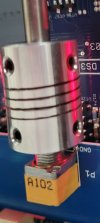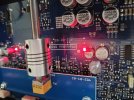For those who are interested, and others with various levels of EMI OCD!
I found an EMI leakage point in the DS3 B mechanical design and addressed it. From the start I’ll state that I can’t hear a difference (because the levels are so low) but I can sure measure a difference.
I use the DS3 B with a MC cartridge so use the 60db gain setting. At one point I adjusted the load impedance while the system was at reasonably loud playing volumes, and I heard the distinct sound of injected mains hum, repeatedly; finger on knob – hum, finger off – no hum.
I took the DS3 B down to the mancave and put it on the test bench. This is what I found:
First, the REW performance on the test bench below. Conditions are: USB sound card is Xonar U7 MkII, located in cake tin (yes, a cake tin) to very effectively shield it from external EMI, DS3 B settings at XLR in, load at 150ohms and 60db gain and subsonic filter off (this filter makes quite a difference with 50hz hum components) to match my listening conditions. XLR inputs are open but this doesn't seem to make that much difference.
Here is the default spectrum on the test bench as the reference:
Here is the spectrum with my finger on the impedance load knob:
So, covers off and review of what the issue is. Well, the load knob has a metal connector shaft directly connected to the load potentiometer, with 60db of gain directly on the other side of the potentiometer, so the cause of the issue is quite simple.
Here is my solution:
I placed a length of copper foil with conductive adhesive backing to the shaft, some three rotations just to make sure, and connected the copper foil to a case earth point under the PCB mounting screw as shown.
When assembling the aluminium covers back on I was less that OCD happy with the internal shielding being aluminium only. So, I arranged a copper foil shield on a flexible substrate as shown in the photo below (I used a nickel impregnated fabric used for EM I shielding cut to size to cover the top and both left and right sides which don’t have any steel chassis coverage), but I guess one could use some A4 paper cut to size with the copper film. Photo below. The mounting screws for the aluminium panels pierce the copper cover and do connect to the chassis earth as needed.
Now after all of this, what is the difference: REW spectrum below.
In the first REW diagram the starting 50Hz hum level is at -88dbFS and very prominently standing out , in the modified version the 50hz hum is at -101dbFS and hiding, so a 13db improvement. There are also strange non mains-harmonic spikes here and there; no idea what they are, measurement artifacts I guess.
Now, I admit that the I have had to use large FFT lengths and multiple samples to return these spectrum's, as the EMI is well buried in the random noise generated by the 60db of gain in the DS3 B circuitry. So, as I stated at the start, one cannot hear the difference in use.
I have not bothered with a spectrum of me touching the impedance knob post modification, it is absolutely, completely, no different that the spectrum above; so, OCD mission accomplished.

